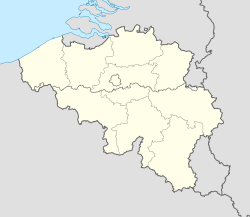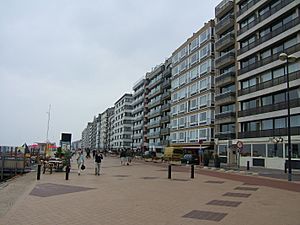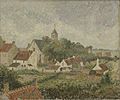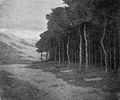Knokke-Heist facts for kids
Quick facts for kids
Knokke-Heist
Knocke-Heist (French)
|
|||
|---|---|---|---|
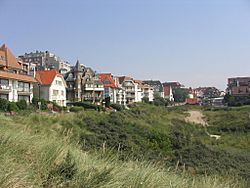 |
|||
|
|||
| Country | Belgium | ||
| Community | Flemish Community | ||
| Region | Flemish Region | ||
| Province | West Flanders | ||
| Arrondissement | Bruges | ||
| Area | |||
| • Total | 56.44 km2 (21.79 sq mi) | ||
| Population
(2018-01-01)Lua error in Module:Wd at line 1575: attempt to index field 'wikibase' (a nil value).
|
|||
| • Total | Lua error in Module:Wd at line 1,575: attempt to index field 'wikibase' (a nil value). | ||
| Postal codes |
8300, 8301
|
||
| Area codes | 050 | ||
| Website | www.knokke-heist.be | ||
Knokke-Heist is a town in Belgium. It is located in the West Flanders province. This area is known for its beautiful coastline.
Knokke-Heist includes several smaller towns. These are Heist-aan-Zee, Knokke, Duinbergen, Ramskapelle, and Westkapelle. In 2006, about 34,063 people lived here. The total area is about 56.44 square kilometers. This means there are about 603 people per square kilometer.
The town is right next to the North Sea. It is in a polder area. Polders are low-lying lands that have been drained. Knokke-Heist is also very close to the border with the Netherlands. It is famous for being a popular and wealthy beach resort in Belgium.
Contents
History of Knokke-Heist
Knokke-Heist has a long and interesting history. It started as a marshy area. Over time, it grew into a popular seaside town.
Early Settlements and Land Reclamation
Long ago, the Zwin area was very marshy. It was mostly home to shepherds and fishermen. Between the 11th and 13th centuries, people started building dykes. These dykes helped to drain the land. This process is called dewatering.
Once the land was dry, farming became possible. People also raised more sheep. New villages were formed. One early settlement was Sint-Anna-ter-Muiden. It even got city rights in 1242.
The Zwin and Medieval Conflicts
The Zwin was an important natural harbor. Its importance was clear during wars. For example, in 1301, there was a war between the Count of Flanders and the French King. Later, during the Hundred Years' War, many battles happened here. The Battle of Sluys in 1340 was one of them.
Local people tried to stay neutral. They were linked to Flanders politically. But they depended on wool from England for their economy. Later, the canal connecting the Zwin to Bruges was made stronger. This happened under Philip the Bold.
Changes from the 15th to 17th Century
The early 15th century saw more English attacks. These attacks hurt the local economy. Peace finally came in 1439. The end of the century brought local rebellions. There was also planned flooding of the polders.
Peace returned during the time of Charles V. This was also when the Zwin started to fill with sand. This made it less useful as a harbor. People then started planting apple orchards. This helped the local economy.
Later, the French Wars of Religion caused more floods. But the economy recovered after the Peace of Westphalia. Farmers started growing rapeseed and potatoes. This strong agricultural growth helped them through tough economic times.
From the 18th Century to Today
In 1713, Knokke became part of the Netherlands. But the old border was put back a few years later. After a battle in 1794, Knokke became part of France.
In 1857, the Leopold Canal was built. This allowed the Zwin to become a natural reserve. Soon after, Knokke and Heist grew as tourist spots. Knokke's population grew a lot. It doubled between 1873 and 1914. It doubled again by 1930. By 1965, it had over 14,000 people. This happened even after the difficulties of World War II.
Cool Places to See in Knokke-Heist
Knokke-Heist has many interesting places to visit. Here are some of them:
- Het Zoute: This area is very fancy. It includes the Royal Zoute Golf Club. This golf club is located in the sand dunes.
- The Zwin: This is a large coastal nature reserve. It covers 158 hectares. It is a salt-water marsh area. It is also a protected place for birds. Many different bird species live here.
- Sincfala Museum: This museum is in Heist. It shows the history of the region. You can learn about how people used to live here.
- Scharpoord: This is a concert hall. Many events and shows take place here.
- "De groetende mannen": This means "the men greeting each other." It is a sculpture by Joep van Lieshout. It shows two large orange men shaking hands.
- Alfred Verwee Sculpture: You can find this sculpture in front of the town hall.
- Beach Sculptures: There are many sculptures on the beach of Knokke-Heist. You can also find them on the wave breakers.
- Pink Fountain: This fountain is located at the tourism center.
- Blue Floating Water Faucet: This is a unique sculpture. It was built by the local water company.
- Rabbit Sculpture: You can find a sculpture of a rabbit at the end of the boardwalk.
Fun Events, Sports, and Culture
Knokke-Heist is a lively place with many activities.
- Art Galleries: The town is home to more than 40 art galleries. You can see many different types of art here.
- Kneistival: This is a free music festival. It lasts for a week every July. It has been happening since 1986.
- Cartoon Festival: The Cartoon Festival of Knokke-Heist is an art gallery. It opens in the summer on the beach. It shows cartoons for both adults and children.
- Carnaval: Knokke-Heist hosts a carnaval every year. It takes place at the end of February.
- Basketball Supercup: The Belgian Basketball Supercup is held in Knokke-Heist.
- Volleyball Supercup: The Belgian Volleyball Supercup also takes place here.
- Miss Belgian Beauty: This Belgian beauty pageant is held in Knokke-Heist.
- Zwin Triathlon: This sports event takes place at the end of September.
Famous People from Knokke-Heist
- Günther Vanaudenaerde: A defense football player, born in 1984.
- David Van Ooteghem: A radio presenter, born in 1975.
Images for kids
See also
 In Spanish: Knokke-Heist para niños
In Spanish: Knokke-Heist para niños




